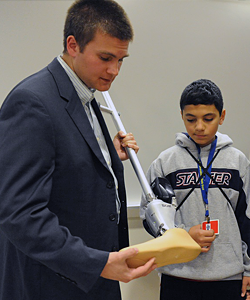NMHM, TATRC Participates in JETS Day 2012 at the Universities at Shady Grove
December 1, 2012, Silver Spring, Md.: Melissa Brachfeld, National Museum of Health and Medicine Public Affairs Office

The past, present and future of prosthetics were recently featured at a Montgomery County conference aimed at inspiring young people to consider a career in science or technology.
The presentation by the National Museum of Health and Medicine (NMHM) and the U.S. Army Medical Research & Materiel Command's Telemedicine & Advanced Technology Research Center (TATRC) took place at the "Journeys in Engineering, Technology and Science (JETS)" Day on December 1, 2012 at the Universities at Shady Grove in Rockville, Md.
JETS Day, now in its fourth year and sponsored by the Universities at Shady Grove and Montgomery County Public Schools, hopes to motivate students to consider careers in science and technology fields, while relating the presentations to the county's middle school science curriculum. Students and their parents heard from speakers in a variety of fields, including bioscience, engineering, computer technology and more, and took part in several interactive hands-on activities. More than 400 Montgomery County students and 350 parents participated in JETS Day in 2011.
Alan Hawk, Historical Collections Manager for NMHM, and Jason Ghannadian, Program Manager for TATRC's Advanced Prosthetics and Neural Engineering Portfolio, gave a presentation entitled, "Lower Limb Prosthetics: Past, Present, and Future." They discussed the history of prosthetic devices, including the leading role of military medicine, with a special emphasis on the lower limbs. Hawk and Ghannadian also touched on current state-of-the-art technology with a focus on the BiOM bionic ankle, which was developed by iWalk, a Bedford, Mass.-based bionics company. Additionally, they explored the future of prosthetics, including brain-controlled prosthetics.
Before giving the presentation, Hawk said he was looking forward to helping students learn a little more about the field of biomedical engineering.
"This is a wonderful opportunity to showcase how biomedical engineers have solved creating prosthetic lower limbs in the past, alongside how it is being solved now," he said.
Ghannadian, a biomedical engineer himself, said, "Prosthetic limbs have evolved a great deal within the past few years and I am excited to showcase the bright future for this dynamic field, as well as highlight the advancements directly from our portfolio."
NMHM recently relocated to Montgomery County and opened all-new exhibits at its new building in Silver Spring. Two exhibits feature historic and contemporary examples of prosthetic arms and legs, along with other advances in artificial organs and joint replacement devices.



